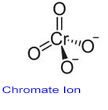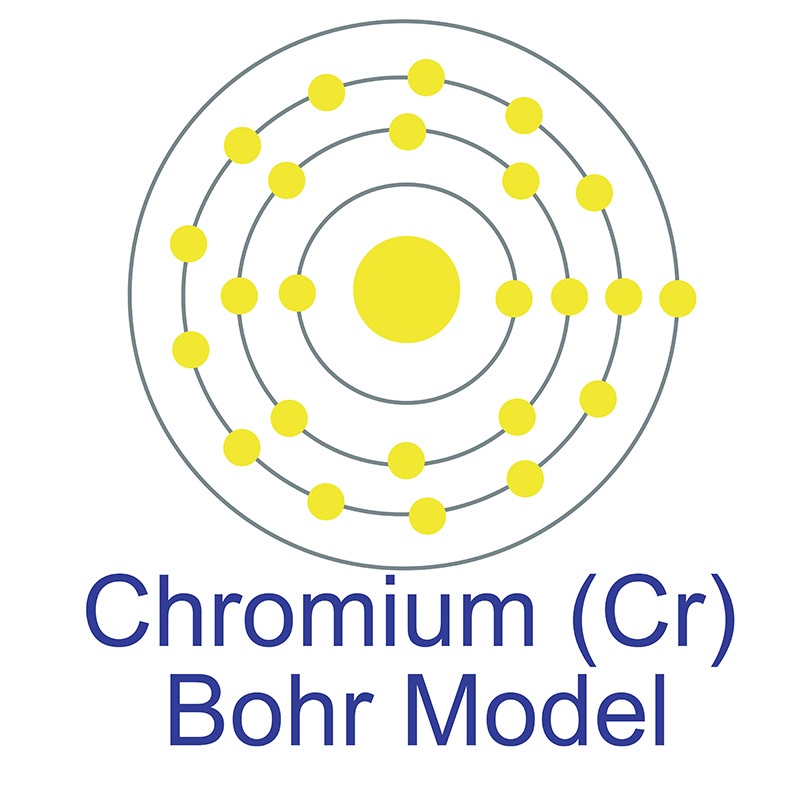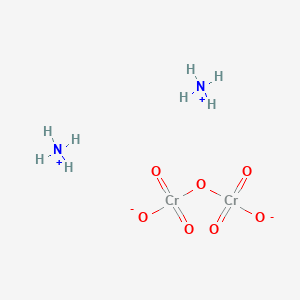SECTION 1. IDENTIFICATION
Product Name: Ammonium Dichromate
Product Number: All applicable American Elements product codes, e.g. AM-CRAT2-02
, AM-CRAT2-03
, AM-CRAT2-04
, AM-CRAT2-05
CAS #: 7789-09-5
Relevant identified uses of the substance: Scientific research and development
Supplier details:
American Elements
10884 Weyburn Ave.
Los Angeles, CA 90024
Tel: +1 310-208-0551
Fax: +1 310-208-0351
Emergency telephone number:
Domestic, North America: +1 800-424-9300
International: +1 703-527-3887
SECTION 2. HAZARDS IDENTIFICATION
Classification
This chemical is considered hazardous by the 2012 OSHA Hazard Communication Standard (29 CFR 1910.1200)
Oxidizing solids Category 2
Acute oral toxicity Category 3
Acute dermal toxicity Category 4
Acute Inhalation Toxicity - Dusts and Mists Category 2
Skin Corrosion/irritation Category 1 B
Serious Eye Damage/Eye Irritation Category 1
Respiratory Sensitization Category 1
Skin Sensitization Category 1
Germ Cell Mutagenicity Category 1B
Carcinogenicity Category 1A
Reproductive Toxicity Category 1B
Specific target organ toxicity - (repeated exposure) Category 1
Combustible dust Yes
Label Elements
Signal Word: Danger
Hazard Statements
May intensify fire; oxidizer
May form combustible dust concentrations in air
Toxic if swallowed
Harmful in contact with skin
Fatal if inhaled
Causes severe skin burns and eye damage
May cause allergy or asthma symptoms or breathing difficulties if inhaled
May cause an allergic skin reaction
May cause genetic defects
May cause cancer
May damage fertility. May damage the unborn child
Causes damage to organs through prolonged or repeated exposure
Precautionary Statements
Prevention
Obtain special instructions before use
Do not handle until all safety precautions have been read and understood
Use personal protective equipment as required
Wash face, hands and any exposed skin thoroughly after handling
Do not eat, drink or smoke when using this product
Do not breathe dust/fume/gas/mist/vapors/spray
Use only outdoors or in a well-ventilated area
Wear respiratory protection
In case of inadequate ventilation wear respiratory protection
Contaminated work clothing should not be allowed out of the workplace
Wear protective gloves
Response
Immediately call a POISON CENTER or doctor/physician
Inhalation
IF INHALED: Remove victim to fresh air and keep at rest in a position comfortable for breathing
Skin
Wash contaminated clothing before reuse
IF ON SKIN (or hair): Take off immediately all contaminated clothing. Rinse skin with water/shower
If skin irritation or rash occurs: Get medical advice/attention
Eyes
IF IN EYES: Rinse cautiously with water for several minutes. Remove contact lenses, if present and easy to do. Continue rinsing
Ingestion
Rinse mouth
Do NOT induce vomiting
Storage
Store locked up
Store in a well-ventilated place. Keep container tightly closed
Disposal
Dispose of contents/container to an approved waste disposal plant
Hazards not otherwise classified (HNOC)
Very toxic to aquatic life with long lasting effects
WARNING. Cancer and Reproductive Harm
SECTION 3. COMPOSITION/INFORMATION ON INGREDIENTS
Component: Ammonium bichromate
CAS-No: 7789-09-5
Weight %: >95
SECTION 4. FIRST AID MEASURES
Eye Contact Rinse immediately with plenty of water, also under the eyelids, for at least 15 minutes.
Immediate medical attention is required.
Skin Contact Wash off immediately with soap and plenty of water while removing all contaminated
clothes and shoes. Immediate medical attention is required.
Inhalation Move to fresh air. Do not use mouth-to-mouth method if victim ingested or inhaled the
substance; give artificial respiration with the aid of a pocket mask equipped with a one-way
valve or other proper respiratory medical device. Immediate medical attention is required. If not breathing, give artificial respiration.
Ingestion Do not induce vomiting. Call a physician or Poison Control Center immediately.
Most important symptoms and effects
Breathing difficulties. Causes burns by all exposure routes. May cause allergy or asthma
symptoms or breathing difficulties if inhaled. May cause allergic skin reaction. Product is a
corrosive material. Use of gastric lavage or emesis is contraindicated. Possible perforation
of stomach or esophagus should be investigated: Ingestion causes severe swelling, severe
damage to the delicate tissue and danger of perforation: Symptoms of allergic reaction may
include rash, itching, swelling, trouble breathing, tingling of the hands and feet, dizziness,
lightheadedness, chest pain, muscle pain or flushing
Notes to Physician Treat symptomatically
SECTION 5. FIREFIGHTING MEASURES
Suitable Extinguishing Media Water.
Unsuitable Extinguishing Media No information available
Flash Point No information available
Method - No information available
Autoignition Temperature 218 °C / 424.4 °F
Explosion Limits
Upper No data available
Lower No data available
Oxidizing Properties Oxidizer
Sensitivity to Mechanical Impact No information available
Sensitivity to Static Discharge No information available
Specific Hazards Arising from the Chemical
Oxidizer: Contact with combustible/organic material may cause fire. Risk of explosion if heated under confinement. Dust can form
an explosive mixture in air. Very toxic. Corrosive Material. Thermal decomposition can lead to release of irritating gases and
vapors. Keep product and empty container away from heat and sources of ignition. Do not allow run-off from fire fighting to enter
drains or water courses.
Hazardous Combustion Products
Nitrogen oxides (NOx) Highly toxic fumes Chromium oxide
Protective Equipment and Precautions for Firefighters
As in any fire, wear self-contained breathing apparatus pressure-demand, MSHA/NIOSH (approved or equivalent) and full
protective gear.
NFPA
Health 4
Flammability 1
Instability 3
Physical hazards OX
SECTION 6. ACCIDENTAL RELEASE MEASURES
Personal Precautions Wear self-contained breathing apparatus and protective suit. Evacuate personnel to safe areas. Ensure adequate ventilation. Avoid dust formation. Remove all sources of ignition.
Do not get in eyes, on skin, or on clothing.
Environmental Precautions Do not flush into surface water or sanitary sewer system. Do not allow material to contaminate ground water system. Prevent product from entering drains. Local authorities should be advised if significant spillages cannot be contained. Should not be released into the environment.
Methods for Containment and Clean Up
Wear self-contained breathing apparatus and protective suit. Keep combustibles (wood,
paper, oil, etc) away from spilled material. Remove all sources of ignition. Sweep up or
vacuum up spillage and collect in suitable container for disposal. Avoid dust formation.
SECTION 7. HANDLING AND STORAGE
Handling Use only under a chemical fume hood. Wear personal protective equipment. Avoid dust
formation. Do not get in eyes, on skin, or on clothing. Do not breathe dust. Do not ingest.
Keep away from clothing and other combustible materials. Keep away from open flames, hot surfaces and sources of ignition. Use spark-proof tools and explosion-proof equipment.
Storage Keep containers tightly closed in a dry, cool and well-ventilated place. Keep away from heat and sources of ignition. Do not store near combustible materials. Containers should be
vented periodically in order to overcome pressure buildup. Corrosives area.
SECTION 8. EXPOSURE CONTROLS/PERSONAL PROTECTION
Exposure Guidelines
Component
Ammonium bichromate
ACGIH TLV
TWA: 0.05 mg/m3
OSHA PEL
(Vacated) Ceiling: 0.1 mg/m3
Ceiling: 0.1 mg/m3
NIOSH IDLH
IDLH: 15 mg/m3
TWA: 0.0002 mg/m3
Mexico OEL (TWA)
TWA: 0.05 mg/m3 TWA: 0.5
mg/m3
Engineering Measures Use only under a chemical fume hood. Use explosion-proof
electrical/ventilating/lighting/equipment. Ensure that eyewash stations and safety showers are close to the workstation location.
Personal Protective Equipment
Eye/face Protection Wear appropriate protective eyeglasses or chemical safety goggles as described by OSHA's eye and face protection regulations in 29 CFR 1910.133 or European Standard
EN166.
Skin and body protection Wear appropriate protective gloves and clothing to prevent skin exposure.
Respiratory Protection Follow the OSHA respirator regulations found in 29 CFR 1910.134 or European Standard
EN 149. Use a NIOSH/MSHA or European Standard EN 149 approved respirator if
exposure limits are exceeded or if irritation or other symptoms are experienced.
Hygiene Measures Handle in accordance with good industrial hygiene and safety practice.
SECTION 9. PHYSICAL AND CHEMICAL PROPERTIES
Physical State Solid
Appearance Orange
Odor Odorless
Odor Threshold No information available
pH 3-4 10% aq. sol
Melting Point/Range 170 °C / 338 °F
Boiling Point/Range No information available
Flash Point No information available
Evaporation Rate Not applicable
Flammability (solid,gas) No information available
Flammability or explosive limits
Upper No data available
Lower No data available
Vapor Pressure No information available
Vapor Density Not applicable
Specific Gravity 2.1500
Solubility 360 g/l (20°C
Partition coefficient; n-octanol/water No data available
Autoignition Temperature 218 °C / 424.4 °F
Decomposition Temperature 170 °C
Viscosity Not applicable
Molecular Formula H8 Cr2 N2 O7
Molecular Weight 252.07
SECTION 10. STABILITY AND REACTIVITY
Reactive Hazard Yes
Stability Oxidizer: Contact with combustible/organic material may cause fire. Risk of explosion by
shock, friction, fire or other sources of ignition. Risk of explosion if heated under
confinement.
Conditions to Avoid Avoid shock and friction. Excess heat. Incompatible products. Combustible material. Avoid dust formation.
Incompatible Materials Acids, Bases, Alcohols, Reducing agents
Hazardous Decomposition ProductsNitrogen oxides (NOx), Highly toxic fumes, Chromium oxide
Hazardous Polymerization Hazardous polymerization does not occur.
Hazardous Reactions None under normal processing.
SECTION 11. TOXICOLOGICAL INFORMATION
Acute Toxicity
Product Information
Component Information
Component
Ammonium bichromate
LD50 Oral
LD50 = 48 mg/kg ( Rat )
LD50 Dermal
LD50 = 1860 mg/kg ( Rabbit )
LC50 Inhalation
LC50 = 0.2 mg/L ( Rat ) 4 h
Toxicologically Synergistic
Products
No information available
Delayed and immediate effects as well as chronic effects from short and long-term exposure
Irritation Causes burns by all exposure routes
Sensitization May cause sensitization by inhalation and skin contact
Mutagenic Effects Mutagenic; May cause heritable genetic damage
Reproductive Effects May impair fertility.
Developmental Effects May cause harm to the unborn child.
Teratogenicity Teratogenic effects have occurred in experimental animals.
STOT - single exposure None known
STOT - repeated exposure None known
Aspiration hazard No information available
Symptoms / effects,both acute and delayed
Product is a corrosive material. Use of gastric lavage or emesis is contraindicated.
Possible perforation of stomach or esophagus should be investigated: Ingestion causes
severe swelling, severe damage to the delicate tissue and danger of perforation: Symptoms
of allergic reaction may include rash, itching, swelling, trouble breathing, tingling of the
hands and feet, dizziness, lightheadedness, chest pain, muscle pain or flushing
Endocrine Disruptor Information No information available
Other Adverse Effects The toxicological properties have not been fully investigated.
SECTION 12. ECOLOGICAL INFORMATION
Ecotoxicity
Very toxic to aquatic organisms, may cause long-term adverse effects in the aquatic environment. The product contains following substances which are hazardous for the environment. Do not allow material to contaminate ground water system.Persistence and Degradability May persist based on information available.
Bioaccumulation/ Accumulation No information available.
Mobility Will likely be mobile in the environment due to its water solubility.
SECTION 13. DISPOSAL CONSIDERATIONS
Waste Disposal Methods Chemical waste generators must determine whether a discarded chemical is classified as a hazardous waste. Chemical waste generators must also consult local, regional, and national hazardous waste regulations to ensure complete and accurate classification.
SECTION 14. TRANSPORT INFORMATION
DOT
UN-No UN1439
Proper Shipping Name AMMONIUM DICHROMATE
Hazard Class 5.1
Packing Group II
TDG
UN-No UN1439
Proper Shipping Name AMMONIUM DICHROMATE
Hazard Class 5.1
Packing Group II
IATA
UN-No UN1439
Proper Shipping Name AMMONIUM DICHROMATE
Hazard Class 5.1
Packing Group II
IMDG/IMO
UN-No UN1439
Proper Shipping Name AMMONIUM DICHROMATE
Hazard Class 5.1
Packing Group II
SECTION 15. REGULATORY INFORMATION
U.S. Federal Regulations
TSCA 12(b)
Component TSCA 12(b)
Ammonium bichromate Section 6
SARA 313
Component CAS-No Weight % SARA 313 - Threshold
Values %
Ammonium bichromate 7789-09-5 >95 0.1 1.0
SARA 311/312 Hazard Categories See section 2 for more information
CWA (Clean Water Act)
Component CWA - Hazardous
Substances
CWA - Reportable
Quantities
CWA - Toxic Pollutants CWA - Priority Pollutants
Ammonium bichromate X 10 lb X -
Clean Air Act
Component HAPS Data Class 1 Ozone Depletors Class 2 Ozone Depletors
Ammonium bichromate X -
OSHA Occupational Safety and Health Administration
Component Specifically Regulated Chemicals Highly Hazardous Chemicals
Ammonium bichromate 5 μg/m3 TWA
2.5 μg/m3 Action Level
-
CERCLA This material, as supplied, contains one or more substances regulated as a hazardous
substance under the Comprehensive Environmental Response Compensation and Liability
Act (CERCLA) (40 CFR 302)
Component Hazardous Substances RQs CERCLA EHS RQs
Ammonium bichromate 10 lb -
California Proposition 65 This product contains the following proposition 65 chemicals
Component CAS-No California Prop. 65 Prop 65 NSRL Category
Ammonium bichromate 7789-09-5 Carcinogen
Developmental
Female Reproductive
Male Reproductive
0.001 μg/day Developmental
Carcinogen
U.S. State Right-to-Know
Regulations
Component Massachusetts New Jersey Pennsylvania Illinois Rhode Island
Ammonium bichromate X X X X X
U.S. Department of Transportation
Reportable Quantity (RQ): N
DOT Marine Pollutant N
DOT Severe Marine Pollutant N
U.S. Department of Homeland Security
This product does not contain any DHS chemicals.
Other International Regulations
Mexico - Grade No information available
SECTION 16. OTHER INFORMATION
Safety Data Sheet according to Regulation (EC) No. 1907/2006 (REACH). The above information is believed to be correct but does not purport to be all inclusive and shall be used only as a guide. The information in this document is based on the present state of our knowledge and is applicable to the product with regard to appropriate safety precautions. It does not represent any guarantee of the properties of the product. American Elements shall not be held liable for any damage resulting from handling or from contact with the above product. See reverse side of invoice or packing slip for additional terms and conditions of sale. COPYRIGHT 1997-2022 AMERICAN ELEMENTS. LICENSED GRANTED TO MAKE UNLIMITED PAPER COPIES FOR INTERNAL USE ONLY.

 The number of electrons in each of Chromium's shells is 2, 8, 13, 1 and its electron configuration is [Ar] 3d5 4s1. Louis Nicolas Vauquelin first discovered chromium in 1797 and first isolated it the following year. The chromium atom has a radius of 128 pm and a Van der Waals radius of 189 pm. In its elemental form, chromium has a lustrous steel-gray appearance.
The number of electrons in each of Chromium's shells is 2, 8, 13, 1 and its electron configuration is [Ar] 3d5 4s1. Louis Nicolas Vauquelin first discovered chromium in 1797 and first isolated it the following year. The chromium atom has a radius of 128 pm and a Van der Waals radius of 189 pm. In its elemental form, chromium has a lustrous steel-gray appearance.  Chromium is the hardest
Chromium is the hardest 
